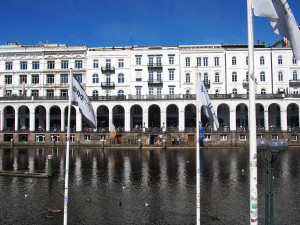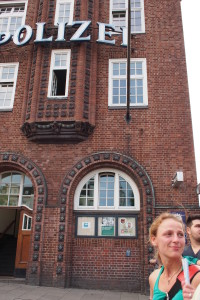On Friday morning, both my Swiss group and I were at the ZOB, our meeting point, on time so that we could start our city tour straight away. After driving around the Outer Alster Lake through one of Hamburg’s posh districts and getting to know street names such as “Bellevue” and “Schöne Aussicht”, we were able to admire the Islamic Center in Hamburg and the Outer Alster Lake in a somewhat hazy day. As a qualified tour guide, I always order sunshine for my city tours in Hamburg :-), but sometimes my wish is not granted :-(. After a look at the Hotel Atlantic, the permanent home of Udo Lindenberg, we were able to take a short detour around the Binnenalster and visit the legendary Jungfernstieg. We continued on our guided tour through Mönckebergstraße past Hamburg City Hall so that we could see where our tour would end at around 12 noon. From there, past the Laeiszhalle, through Hamburg’s new composers’ quarter, we reached the Michel (official name: St. Michaelis), which unfortunately we could only partially admire from the inside, as preparations for the harvest festival at the weekend were in full swing. Directly from this holy site, we then drove over the “Sinful Mile”, the Reeperbahn, the former no-man’s land between Hamburg and Altona, which is now called the “Kiez” by the people of Hamburg. A slow drive through the Große Freiheit gave us a glimpse of the evening. Then our city tour in Hamburg took us down to the port, past the fish market and Blohm + Voss, Hamburg’s largest employer in the port, the second largest port in Europe.
The fact that this port has to contend with a tidal range of around 3.60 m can also be seen at the Landungsbrücken, which we saw shortly afterwards on the right-hand side behind the Old Elbe Tunnel. On the left is Hamburg’s oldest subway railroad (also known as the elevated railroad due to its above-ground route), on the right the museum ships Rickmer Rickmers and Cap San Diego. – This Hamburg tour includes all the highlights of Hamburg – We crossed the Kornhausbrücke bridge and entered the Speicherstadt warehouse district. Here at the western end, you don’t yet recognize so much of the freshly baked UNESCO World Heritage Site, only when we drove east between the “old” Speicherstadt and the “hypermodern” HafenCity did the old warehouses of the former free port area from the end of the 19th century appear. But HafenCity with its various buildings is also an eye-catcher. Elphi (official name: Elbphilharmonie), Cruise Terminal, Marco Polo Tower; the new district will be extended eastwards to the Elbe bridges by 2025. Passing the Deichtorhallen, Hamburg’s former market halls, we came to the Mö (official name: Mönckebergstraße), Hamburg’s busiest shopping street, and the nucleus of Hamburg. Where the town’s first chapel stood in the 9th century, St. Peter’s Church now stands, steadfastly enduring the hustle and bustle around it. We parked in front of the town hall, which was completed at the end of the 19th century after around 50 years of planning, after the old one had been blown up in the Great Fire of 1842. With its market and arcades, the city center was intended to bring some Italian flair to northern Germany. Our morning tour ended here and everyone went their separate ways… until…
… we met again in the evening at the Landungsbrücken to take another closer look at the Reeperbahn. We had to split up the group, as a neighborhood tour – Reeperbahn tour, St. Pauli tour – whatever you want to call it, is virtually impossible with more than 20 people. After we had climbed Hamburg’s highest “inner city mountain”, we rested a little in front of the Bernhardt Nocht Institute for Tropical Medicine, the world-famous tropical institute. Here my guests heard the first information about the Reeperbahn, prostitution and the contrast between Hamburg and Altona. Through Davidstraße, we also passed Herbertstraße, which is “forbidden” for women, and then arrived at Davidwache, the main guardhouse of the Reeperbahn. From there, we took a short detour into one of the side streets, which are now frequently used by Hamburgers to avoid the approx. 200,000 visitors at the weekend. On the “back” of Grosse Freiheit, we stopped briefly at the former Israelite Hospital and then entered Grosse Freiheit from the north. We took another look at the St. Josef Catholic Church and the former Star Club before deciding to walk past the Olivia Jones Bar and, due to the size of our group, have a drink in a more modern pub on Hans-Albers-Platz. It had to be a Hamburg original: an Apfelkorn – with apples from the Alte Land, in the southwest of Hamburg. We also took the opportunity to watch the ladies on Hans-Albers-Platz “canvassing”. And then the lovely excursion was already over… Robert said goodbye and I accompanied the whole group to the bus. I hope you will come again – to the most beautiful city in the world!



